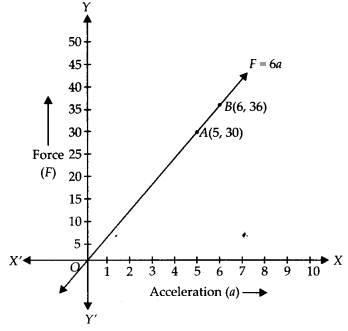NCERT Exemplar Class 9 Maths Chapter 4 Linear Equations in Two Variables
NCERT Exemplar Class 9 Maths Chapter 4 Exercise 4.1
write the correct answer in each of the following:
Question 1.
The linear equation 2x – 5y = 7 has
(A) A unique solution
(B) Two solutions
(C) infinitely many solutions
(D) No solution
Solution:
(C) : For every value of x, we get a corresponding value of y and vice-versa in the given equation. Therefore, the linear equation has infinitely many solutions.
Question 2.
The equation 2x + 5y = 7 has a unique solution, if x, y are:
(A) Natural numbers
(B) Positive real numbers
(C) Real numbers
(D) Rational numbers
Solution:
(A): In natural numbers, there is only one pair i.e., (i, 1) which satisfy the given equation. Therefore, if x, y are natural numbers, given equation has a unique solution.
Question 3.
If (2,0) is a solution of the linear equation 2x + 3y = k, then the value of k is
(A) 4
(B) 6
(C) 5
(D) 2
Solution:
(A) : Put x = 2 and y = 0 in the given equation, we get
2(2) + 3(0) = k ⇒ k = 4
Question 4.
Any solution of the linear equation 2x + 0y + 9 = 0 in two variables is of the form
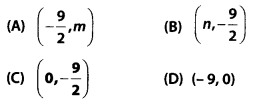
Solution:
(A): The given linear equation is 2x + 0y + 9 = 0
⇒ 2x + 9 = 0 ⇒ 2x = -9 ⇒ x = \(-\frac{9}{2}\)
x = \(-\frac{9}{2}\) and y can be any real number, say m.
Hence, \(\left(-\frac{9}{2}, m\right)\) is the required form of the solution of given linear equation.
Question 5.
The graph of the linear equation 2x + 3y = 6 cuts the y-axis at the point
(A) (2, 0)
(B) (0, 3)
(C) (3, 0)
(D) (0, 2)
Solution:
Since, the graph of the linear equation 2x + 3y = 6 cuts the y-axis, then put x = 0, we get
2(0) + 3y = 6 ⇒ 3y = 6 ⇒ y = \(\frac{6}{3}\) = 2
Hence, the given linear equation cuts the y-axis at the point (0, 2).
Question 6.
The equation x = 7, in two variables, can be written as
(A) 1.x + 1.y = 7
(B) 1.x + 0.y = 7
(C) 0.x + 1.y = 7
(D) 0.x + 0.y = 7
Solution:
(B) : Here, the coefficient of y in the equation x = 7 is 0. So, the equation can be written in two variables as 1.x + 0.y = 7.
Question 7.
Any point on the x-axis is of the form
(A) (x, y)
(B) (0, y)
(C) (x, 0)
(D) (x, x)
Solution:
(C) : Any point on the x-axis has its y-coordinate equal to zero i.e., y = 0.
Hence, the general form of any point on the x-axis is (x, 0)
Question 8.
Any point on the line y = x is of the form
(A) (o, o)
(B) (0, o)
(C) (o, 0)
(D) (o, -o)
Solution:
(A): Any point on the line y = x has same value of x and y-coordinates i.e., x = a and y = a.
Hence, (a, a) is the required form of point on the given line.
Question 9.
The equation of x-axis is of the form
(A) x = 0
(B) y = 0
(C) x + y = 0
(D) x = y
Solution:
(B): The equation of x-axis is of the form y = 0.
Question 10.
The graph of y = 6 is a line
(A) parallel to x-axis at a distance 6 units from the origin.
(B) parallel to y-axis at a distance 6 units from the origin.
(C) making an intercept 6 on the x-axis.
(D) making an intercept 6 on both the axes.
Solution:
(A) : Given equation of a line can be written as, 0.x +1.y = 6
To draw the graph of above equation, we need atleast two solutions.
When x = 0, then y = 6
When x = 2, then y = 6
| x | 0 | 2 |
| y | 6 | 6 |
Hence, we find two points A(0, 6) and B(2, 6). So, draw the graph by plotting these points and joining them, which is shown as follows:
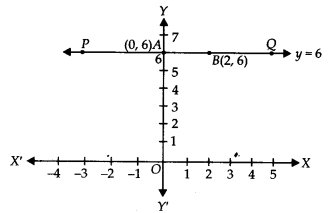
∴ The line PQ parallel to x-axis at a distance 6 units from origin is the required graph of y = 6.
Question 11.
x = 5, y = 2 is a solution of the linear equation
(A) x + 2y = 7
(B) 5x + 2y = 7
(C) x + y = 7
(D) 5x + y = 7
Solution:
(C): (A) Consider x + 2y
On putting x = 5 and y = 2, we get
5 + 2(2) = 5 + 4 = 9 ≠ 7
So, (5, 2) is not a solution of x + 2y = 7
(B) Consider 5x + 2y
On putting x = 5 and y = 2, we get
5(5) + 2(2) = 25 + 4 = 29 ≠ 7
So, (5, 2) is not a solution of 5x + 2y = 7.
(C) Consider x + y
On putting x = 5 and y = 2, we get
5 + 2 = 7
So, (5, 2) is a solution of x + y = 7.
(D) Consider 5x + y
On putting x = 5 and y = 2, we get
5(5) + 2 = 25 + 2 = 27 ≠ 7
So, (5, 2) is not a solution of 5x + y = 7.
Question 12.
If a linear equation has solutions (-2, 2), (0,0) and (2, -2), then it is of the form
(A) y – x = 0
(B) x + y = 0
(C) -2x + y = 0
(D) -x + 2y = 0
Solution:
Let us consider a linear equation ax + by + c = 0. …(i)
Since, (-2, 2), (0, 0) and (2, -2) are the solutions of linear equation therefore, it satisfies the equation (i).
At (-2,2), – 2a + 2b + c = 0 …(ii)
At (0, 0), 0 + 0 + c = 0 ⇒ c = 0 …(iii)
and at (2, -2), 2a-2b + c = 0 …(iv)
From (ii) and (iii), we get
c = 0 and -2a + 2b + 0 = 0
⇒ -2a = -2b ⇒ a = b
On putting a = b and c = 0 in (i), we get
bx + by + 0 = 0 ⇒ bx + by = 0
⇒ b(x + y) = 0 ⇒ x + y = 0, b≠0
Hence, x + y = 0 is the required form of the linear equation.
Question 13.
The positive solutions of the equation ax + by + c = 0 always lie in the
(A) 1st quadrant
(B) 2nd quadrant
(C) 3rd quadrant
(D) 4th quadrant
Solution:
(A) : The coordinates of all points in the 1st quadrant are positive. Therefore, if a line passes through the 1st quadrant, then all solutions lying on the line in 1st quadrant must be positive.
Question 14.
The graph of the linear equation 2x+ 3y= 6 is a line which meets the x-axis at the point
(A) (0, 2)
(B) (2, 0)
(C) (3, 0)
(D) (0, 3)
Solution:
(C): Since, the graph of linear equation 2x + 3y = 6 meets the x-axis.
So, putting y = 0 in 2x + 3y = 6, we get
2x + 3(0) = 6 ⇒ 2x = 6 ⇒ x = 3
Hence, the coordinates on x-axis are (3, 0).
Question 15.
The graph of the linear equation y = x passes through the point
(A) (3/2, -3/2)
(B) (0, 3/2)
(C) (1, 1)
(D) \(\left(\frac{-1}{2}, \frac{1}{2}\right)\)
Solution:
(C): The linear equation y = x has same .value of x and y-coordinates. Therefore, the point (1,1) must lie on the line y = x.
Question 16.
If we multiply or divide both sides of a linear equation with a non-zero number, then the solution of the linear equation:
(A) Changes
(B) Remains the same
(C) Changes in case of multiplication only
(D) Changes in case of division only
Solution:
(B): As we know, if we multiply or divide both sides of a linear equation with a non-zero number, then the solution of the linear equation remains unchanged.
Thus, we can say that the solution remains the same.
Question 17.
How many linear equations in x and y can be satisfied by x = 1 and y = 2?
(A) Only one
(B) Two
(C) Infinitely many
(D) Three
Solution:
(C): Let the linear equation be ax + by + c = 0.
On putting x = 1 and y = 2, in above equation, we get, a + 2b + c = 0, where a, b and c are real numbers.
Here, different values of a, b and c satisfy a + 2b + c = 0. Hence, infinitely many linear equations in x and y can be satisfied by x = 1 and y = 2.
Question 18.
The point of the form (a, a) always lies on:
(A) x-axis
(B) y-axis
(C) On the line y = x
(D) On the line x + y = 0
Solution:
(C): Since, the given point (a, a) has same value of x and y-coordinates, therefore, the point (a, a) must be lie on the line y = x.
Question 19.
The point of the form (a, – a) always lies on the line
(A) x = a
(B) y = -a
(C) y = x
(D) x + y = 0
Solution:
(D): Consider option (D),
x + y = a + (-a) = a – a = 0
[Since, given point is (a, – a)]
Hence, the point of the form (a, -a) always lies on the line x + y = 0.
NCERT Exemplar Class 9 Maths Chapter 4 Exercise 4.2
Write whether the following statements are True or False? Justify your answers:
Question 1.
The point (0, 3) lies on the graph of the linear equation 3x + 4y = 12.
Solution:
True
If we put x = 0 and y = 3 in L.H.S. of the given equation, we get
L.H.S. = 3(0) + 4(3) = 0 + 12 = 12 = R.H.S.
Hence, (0, 3) lies on the line 3x + 4y = 12.
Question 2.
The graph of the linear equation x + 2y = 7 passes through the point (0,7).
Solution:
False
If we put x = 0 and y = 7 in L.H.S. of the given equation, we get
L.H.S. = 0 + 2 (7) = 0 + 14 = 14 ≠ 7 = R.H.S.
Hence, (0, 7) does not lie on the line x + 2y = 7.
Question 3.
The graph given below represents the linear equation x + y = 0.
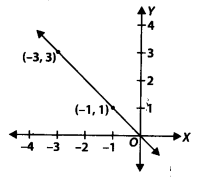
Solution:
True
If the given points (-1, 1) and (-3, 3) lie on the linear equation x + y = 0, then both points will satisfy the equation.
So, at point (-1, 1), we put x = -1, and y = 1 in L.H.S. of the given equation, we get
L.H.S. = x + y = -1 + 1= 0 = R.H.S.
Again, at point (-3, 3), put x = -3 and y = 3 in
L.H.S. of the given equation, we get
L.H.S. = x + y = -3 + 3 = 0 = R.H.S.
Hence, (-1,1) and (-3,3) both satisfy the given linear equation.
Question 4.
The graph given below represents the linear equation x = 3. (See fig.)
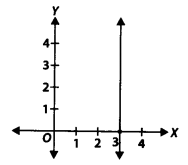
Solution:
True
Since, given graph is a line parallel to y-axis at a distance of 3 units to the right of the origin.
∴ It represents a linear equation x = 3.
Question 5.
The coordinates of points in the table:
| x | 0 | 1 | 2 | 3 | 4 |
| y | 2 | 3 | 4 | -5 | 6 |
represent some of the solutions of the equation x – y + 2 = 0.
Solution:
False
The coordinates of points are (0, 2), (1, 3), (2, 4), (3, -5) and (4, 6).
Given equation is x – y + 2 = 0 …(i)
At (0, 2), L.H.S. of equation (i) = 0 – 2 + 2 = 0 = R.H.S.
At (1, 3), L.H.S. of equation (i) = 1 – 3 + 2 = 0 = R.H.S.
At (2, 4), L.H.S. of equation (i) = 2 – 4 + 2 = 0 = R.H.S.
At (3, -5), L.H.S. of equation (i) = 3 – (-5) + 2 = 3 + 5 + 2 = 10 ≠ R.H.S.
At (4, 6), L.H.S. of equation (i) = 4 – 6 + 2 = 0 = R.H.S.
We observed that (3, -5) does not satisfy the equation.
Therefore, it does not represent the solution of given equation.
Question 6.
Every point on the graph of a linear equation in two variables does not represent a solution of the linear equation.
Solution:
False
Since, every point on the graph of the linear equation represents a solution.
Question 7.
The graph of every linear equation in two variables need not be a line.
Solution:
False
Since, the graph of a linear equation in two variables always represents a line.
NCERT Exemplar Class 9 Maths Chapter 4 Exercise 4.3
Question 1.
Draw the graphs of linear equations y = x and y = – x on the same cartesian plane. What do you observe?
Solution:
The given equation is y = x. To draw the graph of this equation, we need atleast two solutions.
When x = 1, then y = 1
When x = 4, then y = 4
| x | 1 | 4 |
| y | 1 | 4 |
By plotting the points (1, 1) and (4, 4) on the graph paper and joining them by a line, we obtain the graph of y = x.
Similarly, for y = -x.
When x = 3, then y = – 3
When x = — 4, then y = 4
|
x |
3 | -4 |
| y | -3 |
4 |
By plotting the points (3, -3) and (-4, 4) on the graph paper and joining them by a line, we obtain the graph of y = -x
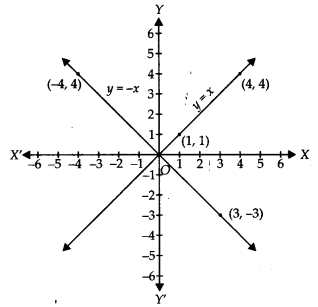
∴ We observe that, the line y = x and y = -x intersect at the point O (0, 0).
Question 2.
Determine the point on the graph of the linear equation 2x + 5y = 19, whose ordinate is \(1 \frac{1}{2}\) times its abscissa.
Solution:
Let x and y be the abscissa and ordinate respectively of the given line 2x + 5y = 19. According to question, we have
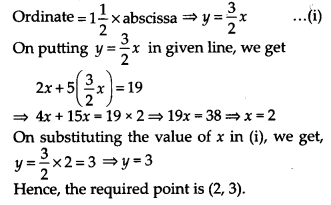
Question 3.
Draw the graph of the equation represented by a straight line which is parallel to the x-axis and at a distance 3 units below it.
Solution:
Any straight line parallel to x-axis and below it i.e., in negative direction of y-axis is given by y = -k, where k units is the distance of the line from the x-axis. Here, k = 3. Therefore, the equation of the line is y = – 3. To draw the graph of this equation, plot the points (1, -3), (2, -3), (3, -3) and join them.
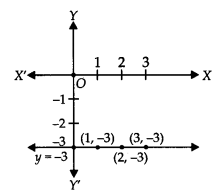
Thus, this is the required graph of equation y = -3.
Question 4.
Draw the graph of the linear equation whose solutions are represented by the points having the sum of the coordinates as 10 units.
Solution:
Let x and y be two coordinates. According to question, the sum of the coordinates is 10 units.
∴ x + y = 10 …(i)
When x = 5, then y = 5
When x = 3, then y = 7
|
x |
5 | 3 |
| y | 5 |
7 |
Now, plotting the points A(5, 5) and B(3, 7) on the graph and joining them by a line, we get graph of the linear equation (i).
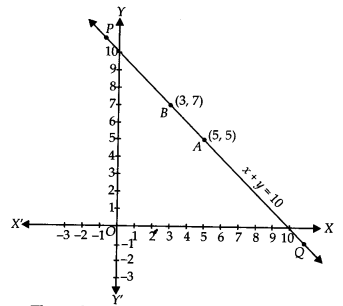
Thus the line PQ is the required graph of x + y = 10
Question 5.
Write the linear equation such that each point on its graph has an ordinate 3 times its abscissa.
Solution:
Let abscissa and ordinate of the point be x and y respectively.
According to the question, we have
Ordinate = 3 × abscissa ⇒ y = 3x
When x = 1, then y = 3
When x = 2, then y = 6
| x | 1 | 2 |
| y | 3 | 6 |
Here, we find two points A(1, 3) and B(2, 6). So, draw the graph by plotting these points and joining them.
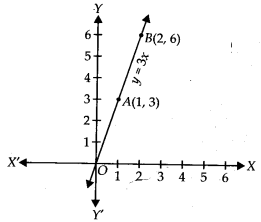
Hence, y = 3x is the required linear equation.
Question 6.
If the point (3, 4) lies on the graph of 3y = ax + 7, then find the value of a.
Solution:
Since, the point (3,4) lies on the equation 3y = ax + 7, then the equation will be satisfied by the point.
Now, put x = 3 and y = 4 in given equation, we get 3(4) = a(3) + 7 ⇒12 = 3a + 7 ⇒ 3a = 5 ⇒ a = \(\frac{5}{3}\)
Hence, the value of a is 5/3
Question 7.
How many solution(s) of the equation 2x + 1 = x – 3 are there on the:
(i) Number line
(ii) Cartesian plane
Solution:
The given equation is 2x + 1 = x – 3
⇒ 2x – x = -3 – 1
∴ x = -4
or 1.x + 0.y = -4
(i) Number line represents all real values of x on the x-axis. Therefore, x = – 4 is exactly one solution of given equation, which lies on the number line as shown below:
![]()
(ii) 1.x + 0.y = -4
Now, when y = 1, x = -4
y = 2, x = – 4
y = -1, x = -4
∴ We get the following table:
| x | -4 | -4 | -4 |
| y | 1 | 2 | -1 |
Plotting the ordered pairs (-4,1), (-4, 2) and (- 4, -1) on a graph paper and joining them, we get a line AB as solution of 1.x + 0.y = – 4 i.e., x = – 4
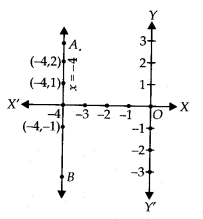
∴ There are infinitely many solutions of the equation 1.x + 0.y = – 4 i.e. x = – 4 on the cartesian plane.
question 8.
Find the solution of the linear equation x + 2y = 8 which represents a point on
(i) x-axis
(ii) y-axis
Solution:
We have, x + 2y = 8 …(1)
(i) When the point is on the x-axis, then put y = 0 in (1), we get x + 2(0) = 8
⇒ x = 8
Hence, the required point is (8, 0).
(ii) When the point is on the y-axis, then put x = 0 in (1), we get 0 + 2y = 8
⇒ y = \(\frac{8}{2}\) = 4
Hence, the required point is (0, 4).
Question 9.
For what value of c, the linear equation 2x + cy = 8 has equal values of x and y for its solution?
Solution:
The given linear equation is 2x + cy = 8 …(i)
According to question, x and y-coordinates of given equation are same, i.e., x = y. Therefore, put y = x in (i), we get

Question 10.
Let y varies directly as x. If y = 12 when x = 4, then write a linear equation. What is the value of y when x = 5?
Solution:
Given that, y varies directly as x
i.e., y ∝ x ⇒ y = kx, …(i)
where k is an arbitrary constant.
On putting y = 12 and x = 4 in (i), we get
![]()
On putting the value of k in (i), we get
y = 3x …(ii)
When x = 5, then (ii) becomes
y = 3 × 5 ⇒ y = 15
Hence, the value of y is 15.
NCERT Exemplar Class 9 Maths Chapter 4 Exercise 4.4
Question 1.
Show that the points A(1, 2), B(-1, -16) and C(0, – 7) lie on the graph of the linear equation y = 9x – 7.
Solution:
Firstly, to draw the graph of equation y = 9x – 7, we need atleast two solutions.
When x = 2, then y = 9(2) – 7 = 18 – 7 = 11
When x = -2, then y = 9(-2) – 7 = -18 – 7 = -25
| x | 2 | -2 |
| y | 11 | -25 |
Here, we find two points P(2, 11) and Q(-2, -25). So, draw the graph by plotting the points P and Q and joining them.
Now, we plot the given points A(1, 2), B(-1, -16) and C(0, -7) on the same graph paper.
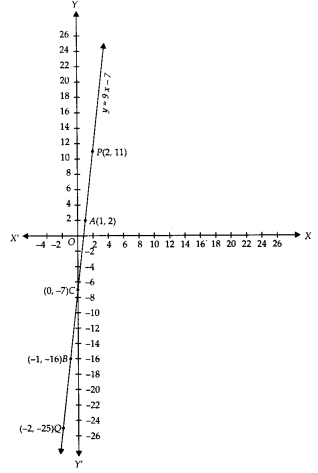
From the above graph, we can see that all the points lie on line PQ.
Question 2.
The following observed values of x and y are thought to satisfy a linear equation. Write the linear equation:
| x | 6 | -6 |
| y | -2 | 6 |
Draw the graph using the values of x, y as given in the above table. At what points the graph of the linear equation
(i) cuts the x-axis
(ii) cuts the y-axis
Solution:
Given, points are (6, -2) and (-6, 6).
Let the linear equation y = mx + c is satisfied by the points (6, -2) and (-6, 6), then at (6, -2), -2 = 6m + c …(i)
and at (-6, 6), 6 = – 6m + c …(ii)
On subtracting (ii) from (i), we get
![]()
On putting the value of m in (i),
we get -2 = 6(-2/3) + c
⇒ -2 = -4 + c ⇒ c = 2
y = mx + c, we get
![]()
When the graph of the linear equation
(i) cuts the x-axis
Then, put y = 0 in equation 2x + 3y = 6, we get 2x + 3 – 0 = 6 ⇒ 2x = 6 ⇒ x = 3
(ii) cuts the y-axis
Then, put x = 0 in equation 2x + 3y = 6, we get
2.0 + 3y = 6 ⇒ 3y = 6 ⇒ y = 2
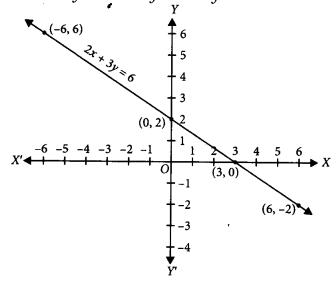
Therefore, the graph of the linear equation 2x + 3y = 6 cuts the x-axis at the point (3,0) and the y-axis at the point (0, 2).
Question 3.
Draw the graph of the linear equation 3x + 4y = 6. At what points, the graph cuts the x-axis and the y-axis?
Solution:
The given equation is 3x + 4y = 6. To draw the graph of this equation, we need atleast two points lying on the graph of
![]()
When x = 2, then y = 0
When x = 0, then y = \(\frac{3}{2}\)
|
x |
2 | 0 |
| y | 0 |
3/2 |
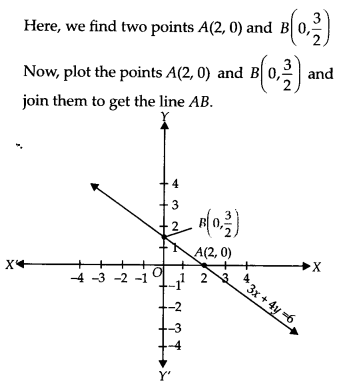
We observed that the line AB cuts the x-axis at the point (2, 0) and the y-axis at the point \(\left(0, \frac{3}{2}\right)\).
Question 4.
The linear equation that converts Fahrenheit (F) to Celsius (C) is given by the relation, C = \(\frac{5 F-160}{9}\).
(i) If the temperature is 86°F, what is the temperature in Celsius?
(ii) If the temperature is 35°C, what is the temperature in Fahrenheit?
(iii) If the temperature is 0°C, what is the temperature in Fahrenheit and if the temperature is 0°F, what is the temperature in Celsius?
(iv) What is the numerical value of the temperature which is same in both the scales?
Solution:
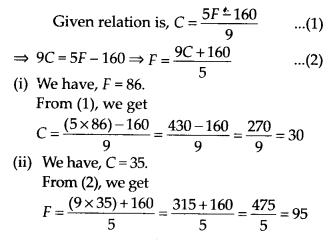
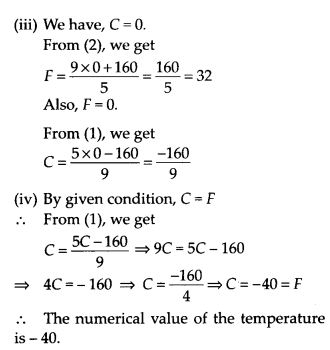
Question 5.
If the temperature of a liquid can be measured in Kelvin units as x°K or in Fahrenheit units as y°F, the relation between the two systems of measurement of temperature is given by the linear equation
y = \(\frac{9}{5}(x-273)+32\)
(i) Find the temperature of the liquid in Fahrenheit, if the temperature of the liquid is 313°K.
(ii) If the temperature is 158°F, then find the temperature in Kelvin.
Solution:
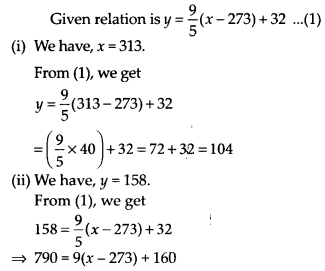

Question 6.
The force exerted to pull a cart is directly proportional to the acceleration produced in the body. Express the statement as a linear equation of two variables and draw the graph of the same by taking the constant mass equal to 6 kg. Read from the graph, the force required when the acceleration produced is
(i) 5 m/sec2
(ii) 6 m/sec2
Solution:
Given that, the force (F) is directly proportional to the acceleration
(a). i.e., F ∝ a
⇒ F = ma,
where, m is a constant mass i.e., m = 6 kg
∴ F = 6a …(1)
(i) If a = 5 m/sec2, then from (1), we get F = (6 × 5) kgm/sec2 = 30 Newton
(ii) If a = 6 m/sec2, then from (1), we get F = (6 × 6) kgm/sec2 = 36 Newton
Here, we find two points A(5, 30) and B(6, 36).
So, draw the graph by plotting these points and joining them.
